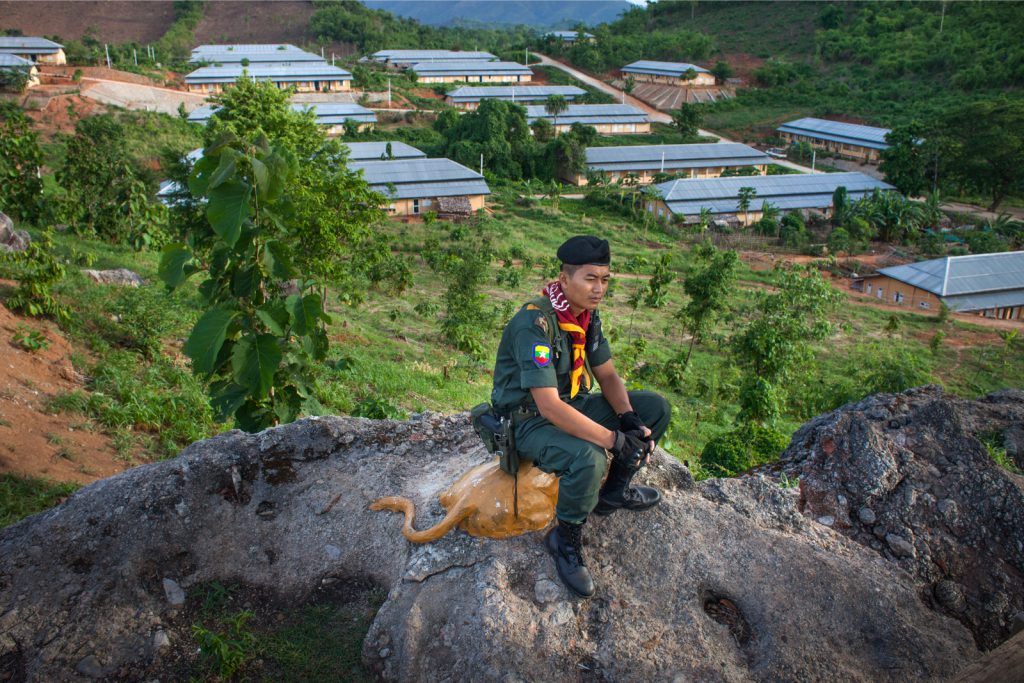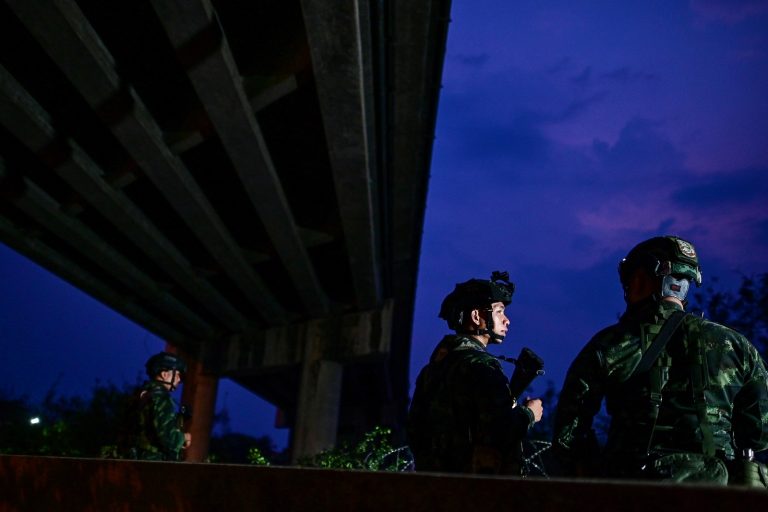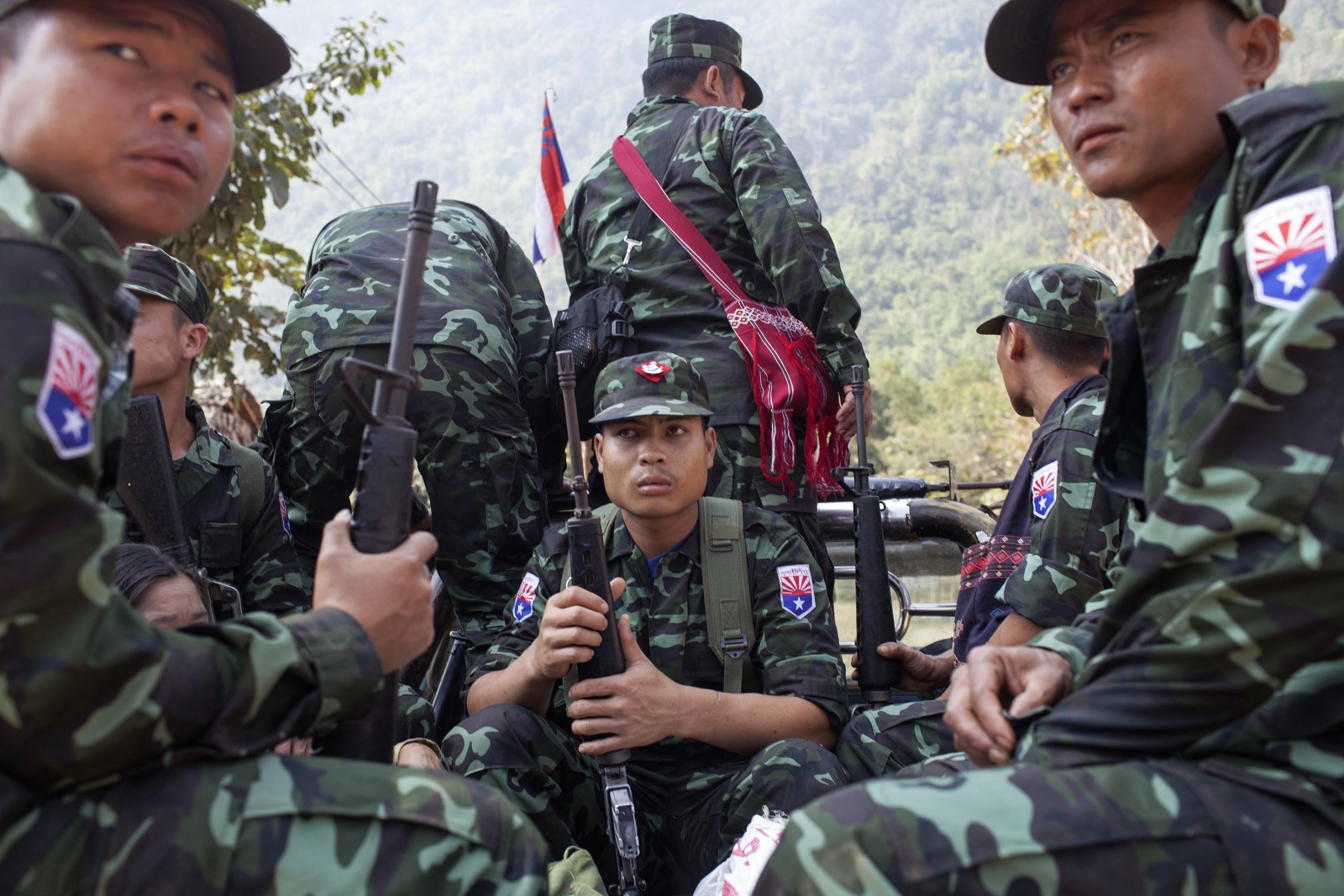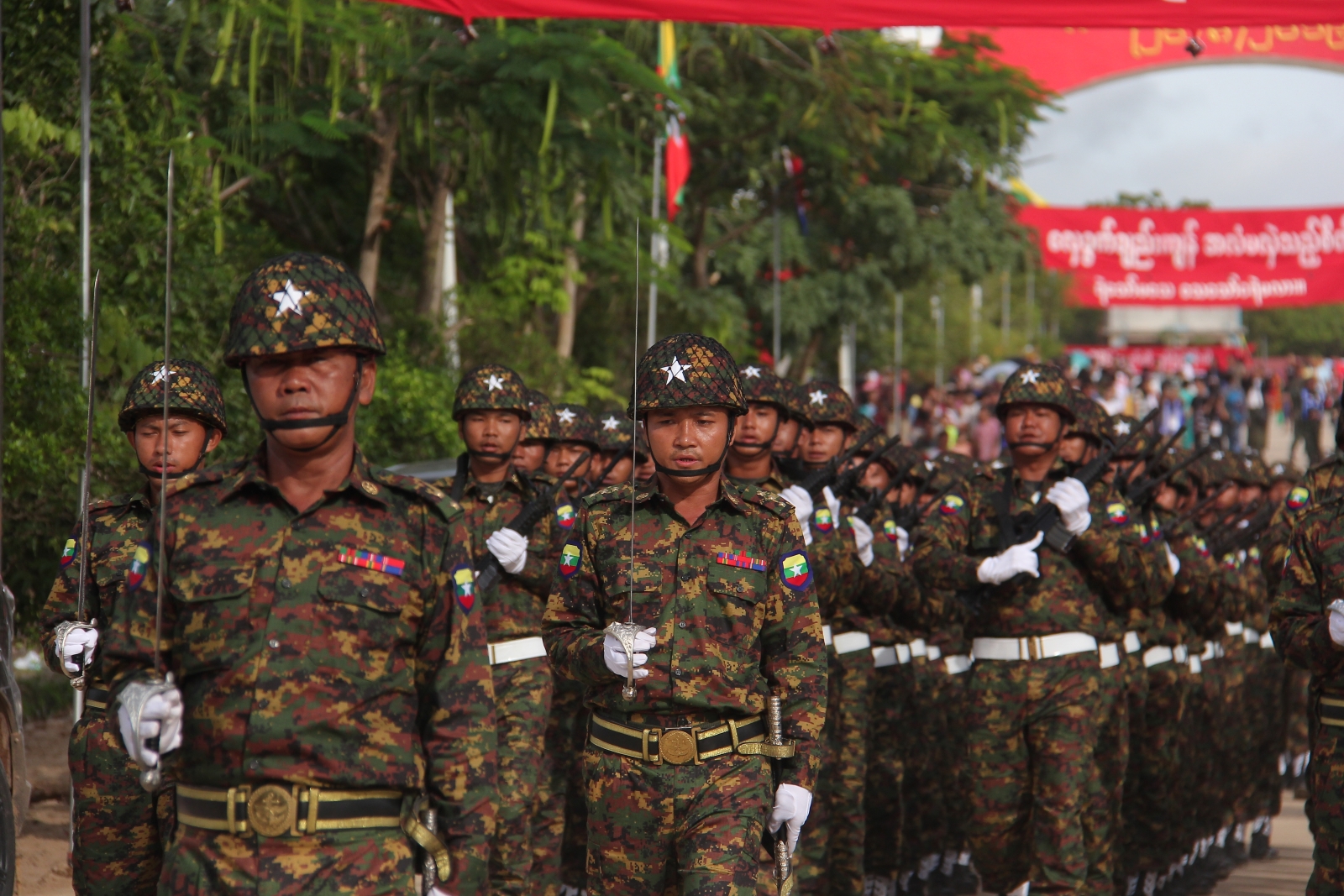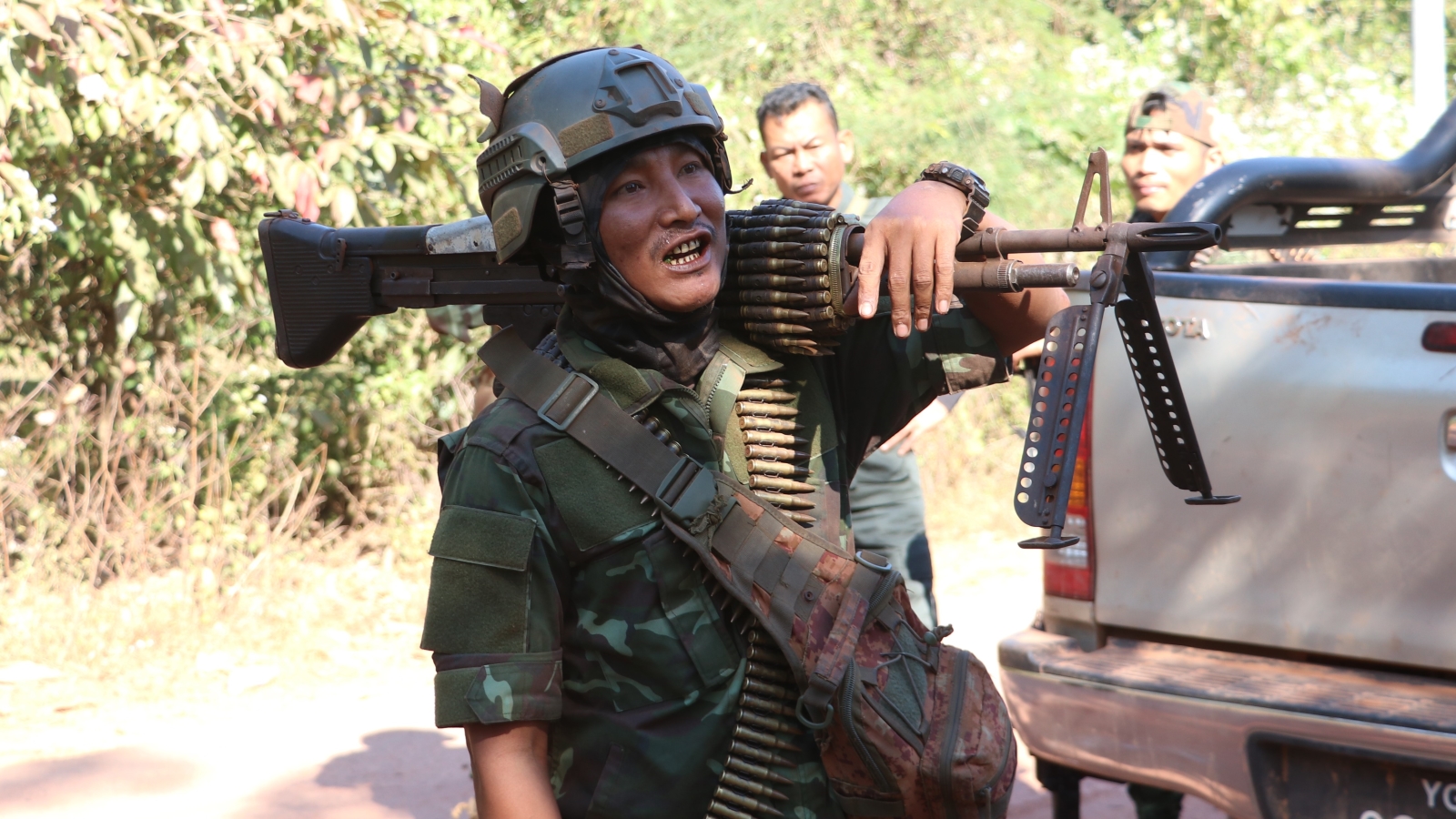By HANS HULST | FRONTIER
Life was slow at the Nangan Tipiti pagoda on Mount Kyauk Gu, just a few miles outside the border town of Myawaddy in Kayin State. Democratic Karen Benevolent Army soldiers sat in the shade resting and chatting, while their commander Major Saw Mote Thon was taking a nap in one of the compound’s wooden houses.
The major said after waking from his siesta that the monastery is one of his favourite hangouts. “I come here often,” he said. “Today five of my officers have been ordained as monks. After a few weeks at the monastery they will go back to active service.”
In the past, the last leg of the journey between the state capital, Hpa-an, and Myawaddy was a stop-go experience, depending on the day. The road between Kawkareik and Myawaddy over the Dawna Ranges was so narrow it could only handle one-way traffic. Traffic travelling in the same direction used the road on alternate days.
With the opening earlier this year of the newly built Asia Highway 1, subsidised by the Asian Development Bank, travel times between Kawkareik and Myawaddy have shrunk considerably. But new nuisances have emerged along the road. There are at least six illegal checkpoints where soldiers ask for a toll, their guns at the ready. The aim is not to provide security but to relieve travellers of the contents of their wallets. After yet another checkpoint and payment of K5,000 even our usually restrained Chin driver grumbled. “This is ridiculous,” he said. “It’s like highway robbery! Thieves!”
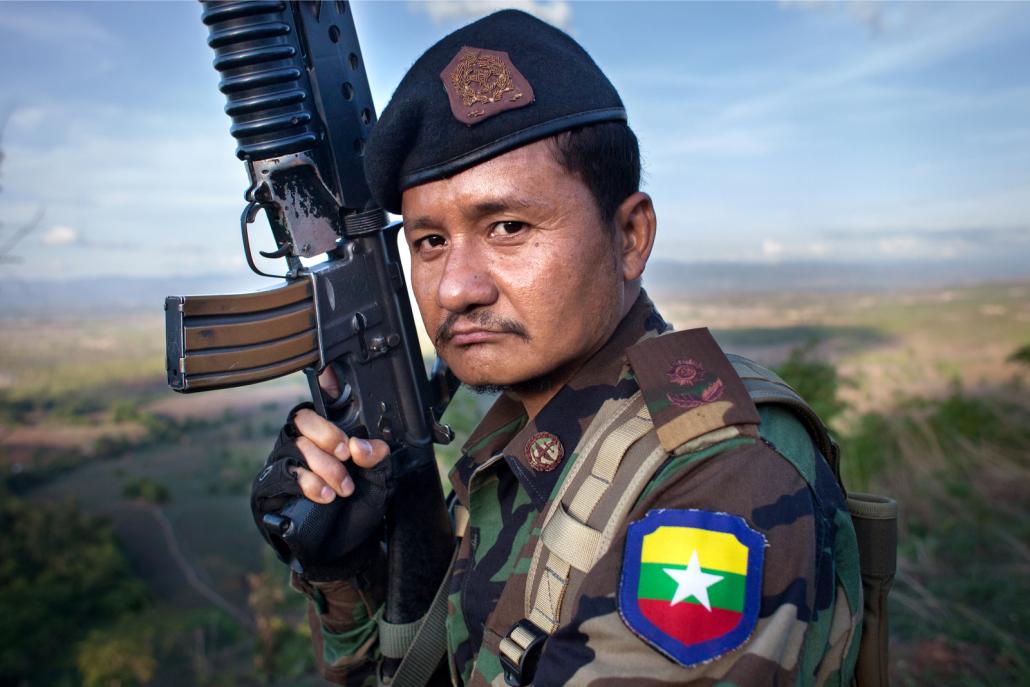
Jeroen de Bakker / Frontier
A Karen National Union official quoted earlier this year in The Irrawaddy had a different perspective of the “highway robbery”. The KNU, which was in active rebellion from 1948 until it agreed a ceasefire in January 2012, did not tax drivers, he said. Travellers were merely “offering financial gratitude out of their own accord,” he told the magazine.
An economist who requested anonymity said a tender has been let for concessions to levy an official highway toll. Exactly how the government intends to end the shady shakedown of drivers by soldiers from armed ethnic groups is unclear. For now the KNU, the DKBA and the DKBA Border Guard Force can pretty much do as they please.
Maj Saw Mote Thon invited us to the command centre of DKBA BGF Battalion 1022, an orderly compound were his troops live in neatly maintained barracks. “I learned to appreciate the importance of cleanliness during a visit to Japan,” he said, while tending his garden in orange boxer shorts and a T-shirt.
The battalion is one of 13 in the DKBA’s Border Guard Force, formed after the government asked ceasefire groups to transform themselves in smaller units to police border areas in joint command with the Tatmadaw. The BGF scheme was announced in the run-up to the 2010 elections but only a few armed ethnic groups agreed to participate.
“For me the worst enemy is alcohol; there is too much drinking in Myanmar. Even in our battalion it is a problem. When people drink they lose their inhibitions and make bad decisions.”
The advantages of joining the scheme are considerable. The government donated land and buildings to DKBA BGF Battalion 1022, said Maj Saw Mote Thon. “They also pay our soldiers’ wages; US$130 a month.” In return the battalion patrolled the area, although the major said that his forces would allow most people cross the border unhindered. The DKBA BGF soldiers will only shoot when troops from other armed ethnic groups trespass on their territory.
In theory, relations between the Karen National Union and the DKBA, which broke away from the KNU in the mid-nineties, are cordial. A Karen Unity and Peace Committee acts as a coordinating body among all armed Karen groups and the KNU and the DKBA intend eventually to merge into one organisation again.
Maj Saw Mote Thon is not involved in the KUPC. “They don’t like my honesty,” he said. “I lead a simple life. I am not picky where I sleep or what I eat.” The major does not regard the KNU and the Tatmadaw as his greatest enemies.
“For me the worst enemy is alcohol; there is too much drinking in Myanmar,” he said. “Even in our battalion it is a problem. When people drink they lose their inhibitions and make bad decisions.” DBKA BGF soldiers who get drunk on Mt Kyauk Gu are punished by being banished to a deep, natural cave. They are lowered into the cave on a rope and must wait in darkness for 24 hours until they are sober again. Sometimes they encounter snakes in the cave.
Maj Saw Mote Thon is a colourful person who runs his battalion with a firm hand. He is friendly but has a tough side and can turn on anyone who crosses him. The high regard in which he is held by his men was evident when we visited one of the battalion’s field positions. The platoon that is patrolling the area had built a chair in the shape of a tiger for their commander.
At the battalion’s central command the major staged a mock battle for us to take photos. His men responded automatically to the major’s orders while he threw rocks into bushes to simulate the presence of imagined enemies. It was an uncomfortable scene to watch grown men being used as pawns on a chessboard.
The Karen National Union, the main adversary of the DKBA, has done well since its return to the legal fold. As part of the preliminary ceasefire agreement signed in 2012, the KNU and the government agreed to open liaison offices. The first office opened in April 2012 at Kyaukkyi in Bago Region. Another five liaison offices have since been opened at Dawei, Thaton, Hpa-an, Myawaddy and Hpayarthonesu.
The aim of the offices is to assist in implementing ceasefire agreements, perform a monitoring role, report misunderstandings and consult with civil society groups and INGOs.
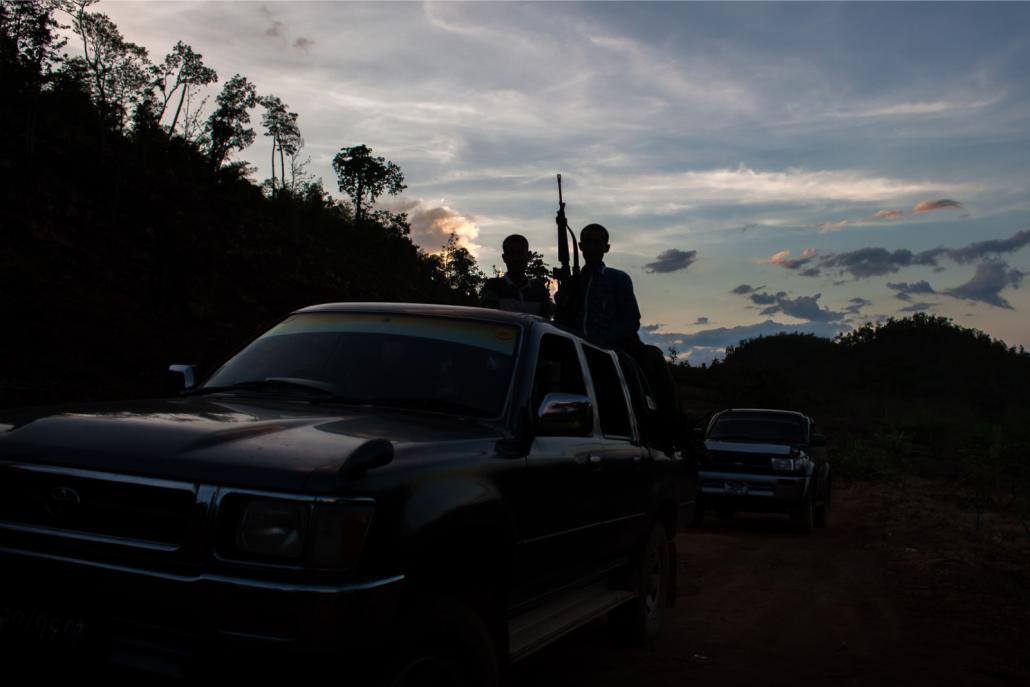
Jeroen de Bakker / Frontier
The KNU liaison office in Myawaddy is run in typical Myanmar fashion. Men in T-shirts sit in the shade while nothing much happens. Sometimes a pick-up enters the compound, delivering even more men. They appear to revel in the easy life provided for them by the government and KNU under the ceasefire agreement.
In an interview at downtown Myawaddy, Saw Hpaw Doh, the chief of staff of the Karen National Liberation Army, the KNU’s armed wing, was conciliatory. “Let bygones be bygones,” he said. “The KNU wants nationwide peace. In 62 years of revolution too many people were killed and the country was hurt. Nobody benefited. We are fighting at the negotiating table now. If the government keeps its promises I am sure that we will find a durable solution.” The clout of the armed ethnic groups in negotiations with the government depends partly on how many troops they have, or say they have.
In 2010 then KNU chair Naw Zipporah Sein claimed the KNLA had a force of 10,000 armed soldiers. Then executive board member Saw David Taw laughed out loud when told of the claim. “How stupid does she think people are?” Saw David Taw said. “The KNU/KNLA has 1,500 soldiers at most. It would not even be able to provide for a large army like that. This will only raise questions about where the money comes from to buy weapons and food for these men.” The current chief of staff of the KNLA did not even blink when he said his army has 20,000 soldiers to pressure the central government.
Arithmetic can also be a challenge for Maj Saw Mote Thon. One day he claimed Battalion 1022 comprised 400 men and the next its ranks had swollen to more than 800. Myanmar Peace Center officials declined to confirm either number because of the sensitive nature of the information.
An expert close to the KNU, who requested anonymity, believes KNLA chief of staff Saw Hpaw Doh also overestimates the strength of the KNU’s armed wing, which has limited itself to guerrilla tactics since the fall of its headquarters at Manerplaw in 1995. The expert estimates that the KNLA fields between 1,500 and 10,000 soldiers.
The creation by the state’s armed groups of the Karen Unity and Peace Committee to foster harmonious relations does not mean that hostilities have ceased. At a house in a DKBA BGF compound in Myawaddy near a profitable border crossing controlled by the group, we met Captain Ko Zaw Oo, who was recovering from a injury suffered during a skirmish in the Karen hinterland.
“The KNLA shot a monk near Myaing Gyi Ngu village,” said Capt Ko Zaw Oo, seated on a bamboo mat. “On April 10 we entered the area with a small platoon of seven DKBA soldiers. We ran into a KNU ambush, though. About 40 KNLA soldiers attacked us. I was wounded in my leg by shrapnel.” He removed the bandage from his calf and foot to show where the metal fragments had entered his body.
The incident begs the question about how peaceful is Kayin State and whether bringing safety and security to its people is possible without weapons being removed from the equation. Are the leaders of the DKBA BGF and the KNU willing to contemplate disarming?
“Out of the question,” said Maj Saw Mote Thon.
“Categorically: no,” said Saw Hpaw Doh. “I don’t even want to discuss it. And we will never enter into the BGF scheme either.” But how can Kayin State achieve peace and security if several contending groups continue to be armed?
“I think if the government is true to its promises the different groups can solve their problems amongst each other,” said Saw Hpaw Doh. “And if somebody did something wrong, we will kill them all. Ha ha.”
Ashley South, an expert on the Karen and the author of Burma’s Longest War: Anatomy of the Karen Conflict, says the unwillingness to disarm is “hardly surprising” given the lack of trust that ethnic minorities have in the government in general and the Tatmadaw in particular.
“It will take years to rebuild trust,” Mr South said. “At some point down the line disarmament will become an important issue in the peace talks, but it will be a difficult issue. It is not realistic that the armed ethnic groups would be demobilising anytime soon. It might literally take generations before we can move on to a truly peaceful Karen State,” he said.
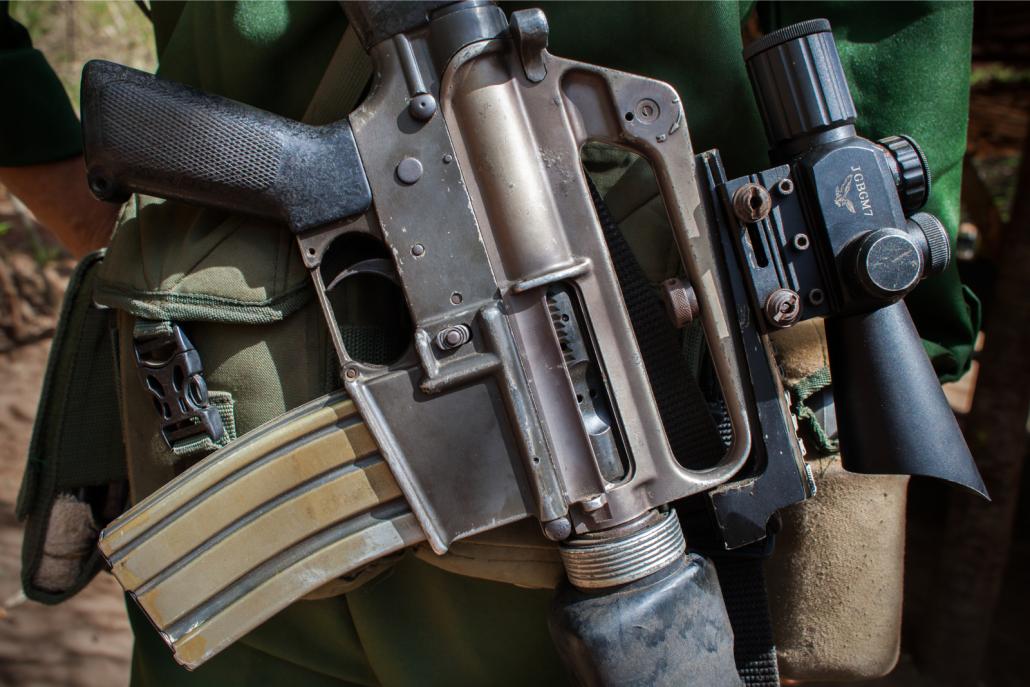
Jeroen de Bakker / Frontier
What are the KNU’s demands?
“What we want to discuss during the political dialogue phase after the Nationwide Peace Accord has been signed are equal rights, self administration and rule of law,” Saw Hpaw Doh said. “Federalism? It is very complex, not the same in every country. I can’t say exactly what our stance is, as we are still internally discussing this subject.”
Asked the same question Maj Saw Mote Thon said the DKBA BGF favours a federal Myanmar as well, but he was not able to go into further detail.
For now relative peace allows DKBA BGF Battalion 1022 to focus firmly on furthering its business interests. Maj Saw Mote Thon painted a rosy picture about opportunities for joint business ventures involving his group. “We have land given to us by the government and we own a mineral water source in Hpa-an. We don’t have the capital or the technology to develop our own water brand. We need investors,” he said.
Attracting investors is no guarantee of success. Maj Saw Mote Thon said a foreign consortium had built a big garment factory on DKBA BGF land near Myawaddy that was expected to employ 4,000 Myanmar. The factory was unable to acquire an operating permit and was relocated to an established industrial zone, shattering the hopes of the DKBA BGF.
It is not only the DKBA BGF that is pursuing business interests. The KNU has a stake in several companies, including the Myawaddy-based Moe Ko San Travel and Tour Company owned by the KNLA’s 7th Brigade and managed by Saw Moses.
How realistic is it for foreigners to invest in troubled Kayin State? It is a classic dilemma, said Mr South. “The area is in desperate need of investment and development, but on the other hand investing is hardly possible if Karen State remains to be politically instable. Any company that wants to invest in conflict sensitive areas in Myanmar needs to be very careful and engage with all the different stakeholders. Most come in [after] engaging mainly with the government. That approach can lead to negative outcomes.”
Are the Karen expecting economic returns from the peace talks? “Resource sharing is obviously part of the discussion,” said Mr South. “But we have to recognise that the fundamental demands of the Karen armed groups are political in nature. They have legitimacy and need to be part of the peace talks.”
The government is covering the cost of the peace process, but that is about to change. When the international community steps in with a multi-donor peace fund later this year, the armed ethnic groups can expect yet another capital injection to fatten their bank accounts.
Before we left Myawaddy Maj Saw Mote Thon emphasised his core message one last time. “Please tell people that we need investors. There are many opportunities here. It will all be for the good of our Karen people.”
Earlier that day we had wondered about the benevolence of the DKBA BGF during a visit to Myit Tha Lin Myaing village. Some of its residents had participated in displays aimed at showing their happy lives under the former rebel army. There were indications the villagers had been coerced. They were reinforced by the reluctance of a nervous village elder to talk to us. A sergeant based in the village served as a go-between as a platoon of soldiers lurked in the background.
We drove off into the darkness ready to face yet again a series of checkpoints thinking peace for the Karen remains a distant ideal, prevented from materialising for now by mistrust on all sides, the need to protect business interests and uncertainties over the outcome of the general election due in November.
Title photo: The DKBA’s Mount Kyauk Gu base. (Jeroen de Bakker / Frontier)


